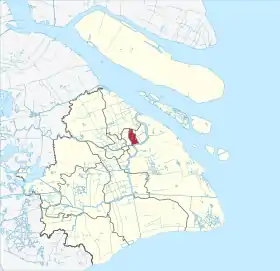Hongkou
虹口区 | |
|---|---|
 The View of The North Bund, Hongkou, Shanghai | |
 Hongkou in Shanghai | |
| Country | People's Republic of China |
| Municipality | Shanghai |
| Area | |
| • Total | 23.48 km2 (9.07 sq mi) |
| Population (2018) | |
| • Total | 1,312,700 |
| • Density | 56,000/km2 (140,000/sq mi) |
| Time zone | UTC+8 (China Standard) |
| Website | www |
| Hongkou, Shanghai | |||||||||||
|---|---|---|---|---|---|---|---|---|---|---|---|
| Simplified Chinese | 虹口区 | ||||||||||
| Traditional Chinese | 虹口區 | ||||||||||
| Postal | Hongkew | ||||||||||
| |||||||||||
ⓘ, formerly spelled Hongkew, is a district of Shanghai, forming part of the northern urban core. It has a land area of 23.48 km2 (9.07 sq mi) and a population of 852,476 as of 2010.
The district borders Yangpu District to the east, Pudong District to the southeast, Huangpu District to the southwest, Jing'an District to the west and Baoshan District to the north.
It is the location of the Astor House Hotel, Broadway Mansions, Lu Xun Park, and Hongkou Football Stadium. It was once known as Shanghai's "Little Tokyo"
Hongkou is home to the Shanghai International Studies University (SISU), the Shanghai University of Finance and Economics (SUFE), and the 1933 Old Millfun.
History
During the Tang dynasty, the area in modern Hongkou District may have been a beach included in a seawall (捍海塘) near the East China Sea. In the early Ming dynasty, it became known as 黃埔口 (Huangpukou) or 洪口 (Hongkou), as there is a river mouth debouched into the Huangpu River, in the early Qing dynasty, it was renamed as 虹口 (Hongkou).[1]
In 1845, an American bishop W. J. Boone bought an area of land there, and it later evolved into the American Concession in Shanghai in 1848 and merged into the International Concession in 1863, it was in large part reduced to rubble during the Second World war when Shanghai was occupied by the Japanese.[2] 20,000 Ashkenazi Jewish refugees from Nazi-occupied Europe lived in an overcrowded square-mile section known to as the Shanghai Ghetto, in the Tilanqiao neighborhood of Hongkew.[3]
In 1947, it was renamed as Hongkou District.
Subdistricts
Hongkou is responsible for the administration of the following subdistricts.
| Name | Chinese (S) | Hanyu Pinyin | Shanghainese Romanization | Population (2010)[4] | Area (km2) |
|---|---|---|---|---|---|
| Ouyang Road Subdistrict | 欧阳路街道 | Ōuyánglù Jiēdào | oe yan lu ka do | 73,328 | 1.67 |
| Quyang Road Subdistrict | 曲阳路街道 | Qūyánglù Jiēdào | chioq yan lu ka do | 102,564 | 3.05 |
| Guangzhong Road Subdistrict | 广中路街道 | Guǎngzhōnglù Jiēdào | kuaon tzon lu ka do | 122,669 | 2.89 |
| Jiaxing Road Subdistrict | 嘉兴路街道 | Jiāxìnglù Jiēdào | cia ka xin lu ka do | 125,634 | 2.63 |
| Liangcheng Xincun Subdistrict | 凉城新村街道 | Liángchéng Xīncūn Jiēdào | lian zen sin tsen ka do | 98,094 | 3.14 |
| Sichuan North Road Subdistrict | 四川北路街道 | Sìchuānběilù Jiēdào | sy tseu poq lu ka do | 87,401 | 2.33 |
| Tilanqiao Subdistrict | 提篮桥街道 | Tílán qiáo Jiēdào | tiq leh djio ka do | 113,751 | 2.36 |
| Jiangwanzhen Subdistrict | 江湾镇街道 | Jiāngwānzhèn Jiēdào | kaon ue tzen ka do | 129,035 | 4.17 |
Economy

Previously Lianhua Supermarket had its Shanghai office in the district.[5]
Schools
- Hongkou Experimental School
- Shanghai Beihong Senior High School
- Shanghai Beijiao Senior High School
- Shanghai Chengzhong Senior High School
- Shanghai Jiguang Senior High School
- Shanghai No.1 Normal Senior High School
- Shanghai Fuxing Senior High School
- Shanghai Hongkou Senior High School
- Shanghai Hainan middle school
International schools
Russian Consulate School in Shanghai is a Russian overseas primary school operated by the Russian Ministry of Foreign Affairs, located on the grounds of the Consulate-General of Russia in Shanghai in Hongkou District.[6]
Transportation
Metro
Hongkou is currently served by five metro lines operated by Shanghai Metro:
- Line 3 - Dongbaoxing Road, Hongkou Football Stadium 8 , Chifeng Road, Dabaishu, Jiangwan Town
- Line 4 - Hailun Road 10 , Linping Road
- Line 8 - Siping Road 10 , Quyang Road, Hongkou Football Stadium 3
- Line 10 - North Sichuan Road, Hailun Road 4 , Youdian Xincun, Siping Road 8
- Line 12 - International Cruise Terminal, Tilanqiao
References
- ↑ "虹口区志>>第一编境域·建置>>第一章境域>>第一节境域变迁" (in Chinese). Shanghai Office for Local Chronicles. Retrieved 2019-07-28.
- ↑ Cosentino, Francesco. SHANGHAI FROM MODERNISM TO MODERNITY (Deluxe ed.). Lulu.com. p. 51. ISBN 9781312985674. Retrieved 4 October 2016.
- ↑ James Griffiths (21 November 2013). "Shanghai's Forgotten Jewish Past". The Atlantic.
- ↑ Census Office of the State Council of the People's Republic of China; Population and Employment Statistics Division of the National Bureau of Statistics of the People's Republic of China (2012). 中国2010人口普查分乡、镇、街道资料 (1 ed.). Beijing: China Statistics Print. ISBN 978-7-5037-6660-2.
- ↑ Lianhua 2003(?) Annual Report (Archive). Lianhua Supermarket. p. 2. "Registered Office 11th to 15th Floors 1666 Sichuan (North) Road Shanghai The PRC Place of Business in Hong Kong 26th to 27th Floors Harcourt Building 39 Gloucester Road Wanchai Hong Kong" - Traditional Chinese (Archive): "註冊辦事處 中國上海 四川北路1666號 11至15樓 香港營業地點 香港灣仔告士打道39號 夏愨大廈26至27樓"
- ↑ "Контакты" (Archive). Russian Consulate School in Shanghai. Retrieved on April 14, 2015. "Адрес: 200080, КНР, г. Шанхай ул. Хуанпу № 20. English: 200000, PRC, Shanghai, Hong Kou Qu Districs [sic], 20 Huang Pu Lu"
Further reading
- "Hongkou District". Encyclopedia of Shanghai. Shanghai Municipal Government. 2010. Archived from the original on 2013-03-02.
External links
 Hongkou District travel guide from Wikivoyage
Hongkou District travel guide from Wikivoyage